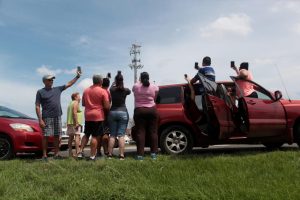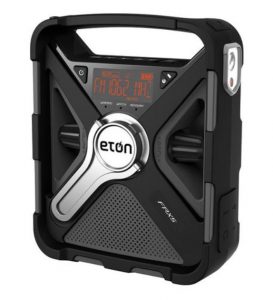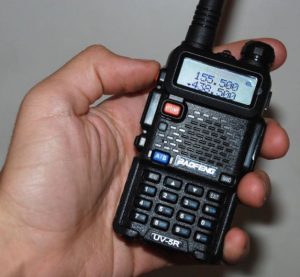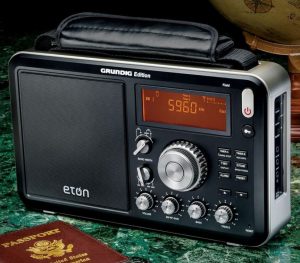
Staying in touch with family and outside world will be a challenge after most events. After the recent hurricanes in Texas, Florida, Puerto Rico, and the East Coast, cellular towers failed as the power grid went down, leaving millions of people without news or communications. With smartphones, few people have an AM/FM radio, and fewer still have weather radios. When the batteries in people’s cell phones went dead, they entered an information vacuum, unable to receive weather updates, food distribution locations, or information about clean water supply points. Suddenly, everyone’s communication range was limited to how loud they could scream. With a little forethought, you can avoid this. Here are some of your options:
 AM/FM/NOAA Weather Radio. Battery powered radios with the NOAA weather band are compact, light and inexpensive. There’s even a special category “Portable Emergency Radios” on eBay with several models selling for under $20. Some are even powered by solar panels and hand crank generators, so no batteries need to be changed or charged up. The NOAA Weather radio is a nice option because even with the radio off, any NOAA emergency Alert system turns on the radio to announce the warning details. One of my favorites is the Eton FRX3 ($55 on eBay, $70 on Eton’s website), which is also recommended by the American Red Cross. The FRX3 is an AM/FM/WX radio powered by AA batteries or the built-in hand crank generator. The hand crank also powers a USB port that can charge electronics. The FRX5 ($70 on eBay, $100 on Eton’s website) is the big brother that has a built-in solar panel. A new model, the FRX2, has everything found in the FRX5, but at a lower price ($40) and more compact package.
AM/FM/NOAA Weather Radio. Battery powered radios with the NOAA weather band are compact, light and inexpensive. There’s even a special category “Portable Emergency Radios” on eBay with several models selling for under $20. Some are even powered by solar panels and hand crank generators, so no batteries need to be changed or charged up. The NOAA Weather radio is a nice option because even with the radio off, any NOAA emergency Alert system turns on the radio to announce the warning details. One of my favorites is the Eton FRX3 ($55 on eBay, $70 on Eton’s website), which is also recommended by the American Red Cross. The FRX3 is an AM/FM/WX radio powered by AA batteries or the built-in hand crank generator. The hand crank also powers a USB port that can charge electronics. The FRX5 ($70 on eBay, $100 on Eton’s website) is the big brother that has a built-in solar panel. A new model, the FRX2, has everything found in the FRX5, but at a lower price ($40) and more compact package.
 Handheld radios. When cellular service fails, so does our ability to communicate beyond the range of our voice, roughly 100 meters. If we’re to keep up with family members or coordinate with neighbors, handheld radios are an option. Radios today are inexpensive, powerful and possess a variety of advanced features. By now you realize that I recommend high quality products with higher than average prices, but this category is the exception. The prepper community has popularized several handheld radios, and their high demand brought prices down. The most popular handheld is the Baofeng UV-5R Dual Band Radio ($25). This dual band/dual power radio (1W/4W) transmits and receives on VHF Ham frequencies (136-174Mhz) and UHF (400-520Mhz). It also receives FM signals (65-108Mhz), into which all of the NOAA Weather Alert bands and commercial FM stations fall.
Handheld radios. When cellular service fails, so does our ability to communicate beyond the range of our voice, roughly 100 meters. If we’re to keep up with family members or coordinate with neighbors, handheld radios are an option. Radios today are inexpensive, powerful and possess a variety of advanced features. By now you realize that I recommend high quality products with higher than average prices, but this category is the exception. The prepper community has popularized several handheld radios, and their high demand brought prices down. The most popular handheld is the Baofeng UV-5R Dual Band Radio ($25). This dual band/dual power radio (1W/4W) transmits and receives on VHF Ham frequencies (136-174Mhz) and UHF (400-520Mhz). It also receives FM signals (65-108Mhz), into which all of the NOAA Weather Alert bands and commercial FM stations fall.
 Short Wave. If the event is widespread, it’ll be useful to have a long-range radio capability to listen to happenings outside of your immediate area. Shortwave signals travel around the world by “skipping” off the ionosphere, so the station you’re listening to may be 100 miles away, or 5000 miles away depending on conditions and your antenna. Shortwave works best at night, when the ionosphere is stable and not ionized by the sun. In general, handheld radios ($20-50) don’t have enough gain to listen effectively to weaker signals. Larger units designed for long range listening have more powerful circuitry and better signal filtering, but are higher in price ($100 and up). A popular mid-range model is the Eton Field Radio ($70 on eBay, $150 on Eton’s website).
Short Wave. If the event is widespread, it’ll be useful to have a long-range radio capability to listen to happenings outside of your immediate area. Shortwave signals travel around the world by “skipping” off the ionosphere, so the station you’re listening to may be 100 miles away, or 5000 miles away depending on conditions and your antenna. Shortwave works best at night, when the ionosphere is stable and not ionized by the sun. In general, handheld radios ($20-50) don’t have enough gain to listen effectively to weaker signals. Larger units designed for long range listening have more powerful circuitry and better signal filtering, but are higher in price ($100 and up). A popular mid-range model is the Eton Field Radio ($70 on eBay, $150 on Eton’s website).
 “Corded” phone (works with no power). This sounds crazy, but it’s a good idea to have an old corded phone stashed away. Most people use cordless phones, but once the power is out they won’t work on landlines. The old corded phones use low voltage supplied by the phone line and work perfectly if the landlines are up. Since phone companies have invested heavily in backup generators and power banks at their switching offices, there’s every chance your line will remain live, even when cellular towers fail. So, keep an eye out when passing yard sales – an old princess phone could turn out to be priceless.
“Corded” phone (works with no power). This sounds crazy, but it’s a good idea to have an old corded phone stashed away. Most people use cordless phones, but once the power is out they won’t work on landlines. The old corded phones use low voltage supplied by the phone line and work perfectly if the landlines are up. Since phone companies have invested heavily in backup generators and power banks at their switching offices, there’s every chance your line will remain live, even when cellular towers fail. So, keep an eye out when passing yard sales – an old princess phone could turn out to be priceless.